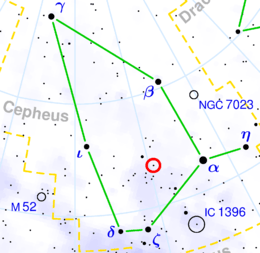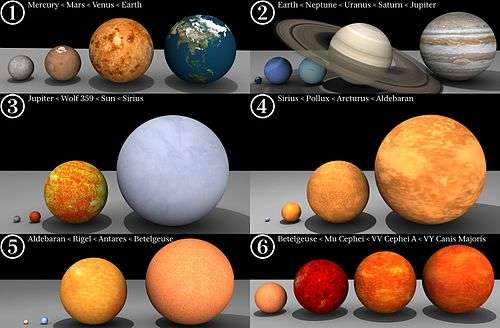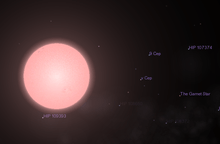VV Cephei
VV Cephei, also known as HD 208816, is an eclipsing binary star system located in the constellation Cepheus, approximately 5,000 light years from Earth. It is both a B[e] star and shell star.
 Location of VV Cephei in Cepheus constellation | |
| Observation data Epoch J2000 Equinox J2000 | |
|---|---|
| Constellation | Cepheus |
| Right ascension | 21h 56m 39.14385s[1] |
| Declination | +63° 37′ 32.0174″[1] |
| Apparent magnitude (V) | 4.91[2] (4.80 - 5.36[3]) |
| Characteristics | |
| U−B color index | +0.43[4] |
| B−V color index | +1.73[4] |
| Variable type | EA + SRc[3] |
| A | |
| Spectral type | M2 Iab[2] |
| U−B color index | +2.07[4] |
| B−V color index | +1.82[4] |
| B | |
| Spectral type | B0-2 V[2] |
| U−B color index | −0.52[4] |
| B−V color index | +0.36[4] |
| Astrometry | |
| Parallax (π) | 1.33 ± 0.20[1] mas |
| Distance | 4.9k ly (1.5k[5] pc) |
| Absolute magnitude (MV) | −6.93[6] |
| Orbit | |
| Period (P) | 7,430.5 days[7] |
| Semi-major axis (a) | 16.2 ± 3.7[2]" (24.8[8] AU) |
| Eccentricity (e) | 0.346 ± 0.01[7] |
| Inclination (i) | 84[9]° |
| Semi-amplitude (K1) (primary) | 19.43 ± 0.33[7] km/s |
| Semi-amplitude (K2) (secondary) | 19.14 ± 0.68[7] km/s |
| Details | |
| A | |
| Mass | 2.5[10] or 18.2[8] M☉ |
| Radius | 516[11] or 1,000[12] R☉ |
| Luminosity | 200,000[13] L☉ |
| Surface gravity (log g) | 0.0[14] cgs |
| Temperature | 3,480 ± 176.8[11] K |
| Metallicity [Fe/H] | −0.06[14] dex |
| B | |
| Mass | 8[10] or 18.6[8] M☉ |
| Radius | 13[7]-25[15] R☉ |
| Metallicity | −0.14[16] |
| Age | 25[17] Myr |
| Other designations | |
| Database references | |
| SIMBAD | data |
VV Cephei is an eclipsing binary with the second longest known period. A red supergiant fills its Roche lobe when closest to a companion blue star, the latter appearing to be on the main sequence. Matter flows from the red supergiant onto the blue companion for at least part of the orbit and the hot star is obscured by a large disk of material. The supergiant primary, known as VV Cephei A, is currently recognised as one of the largest stars in the galaxy although its size is not certain. The best estimate is 1,000 R☉, which is nearly as large as the orbit of Jupiter.
Variability
The fact that VV Cephei is an eclipsing binary system was discovered by American astronomer Dean McLaughlin in 1936. VV Cephei experiences both primary and secondary eclipses during a 20.3 year orbit.[18] The primary eclipses totally obscure the hot secondary star and last for nearly 18 months. Secondary eclipses are so shallow that they have not been detected photometrically since the secondary obscures such a small proportion of the large cool primary star.[9] The timing and duration of the eclipses is variable, although the exact onset is difficult to measure because it is gradual. Only Epsilon Aurigae has a longer period among eclipsing binaries.[2]
VV Cephei also shows semiregular variations of a few tenths of a magnitude. Visual and infrared variations appear unrelated to variations at ultraviolet wavelengths. A period of 58 days has been reported in UV,[19] while the dominant period for longer wavelengths is 118.5 days.[20] The short wavelength variations are thought to be caused by the disc around the hot secondary, while pulsation of the red supergiant primary caused the other variations. It has been predicted that the disc surrounding the secondary would produce such brightness variability.[21]
Spectrum
The spectrum of VV Cep can be resolved into two main components, originating from a cool supergiant and a hot small star surrounded by a disk. The material surrounding the hot secondary produces emission lines, including [FeII] forbidden lines, the B[e] phenomenon known from other stars surrounded by circumstellar disks. The hydrogen emission lines are double-peaked, caused by a narrow central absorption component. This is caused by seeing the disk almost edge on where it intercepts continuum radiation from the star. This is characteristic of shell stars.[18]
Forbidden lines, mainly of FeII but also of CuII and NiII, are mostly constant in radial velocity and during eclipses, so they are thought to originate in distant circumbinary material.[22]
The spectrum varies dramatically during the primary eclipses, particularly at the ultraviolet wavelengths produced most strongly by the hot companion and its disc. The typical B spectrum with some emission is replaced by a spectrum dominated by thousands of emission lines as portions of the disc are seen with the continuum from the star blocked. During ingress and egress, the emission line profiles change as one side or the other of the disc close to the star becomes visible while the other is still eclipsed.[9] The colour of the system as a whole is also changed during eclipse, with much of the blue light from the companion blocked.[2]
Out of eclipses, certain spectral lines vary strongly and erratically in both strength and shape, as well as the continuum. Rapid random variations in the short wavelength (i.e. hot) continuum appear to arise from the disc around the B component. Shell absorption lines show variable radial velocities, possibly due to variations in accretion from the disk. Emission from FeII and MgII strengthens around periastron or secondary eclipses, which occur at about the same time, but the emission lines also vary randomly throughout the orbit.[18]
In the optical spectrum, the Hα is the only clear emission feature. Its strength varies randomly and rapidly out of eclipse, but it becomes much weaker and relatively constant during the primary eclipses.[23]
Distance
The distance has been estimated by a variety of techniques to be around 1.5 kpc, which places it within the Cepheus OB2 association. Some older studies found a larger distance and consequently very high luminosity and radius, but it now seems that the distance is more likely to be around 1.5 kpc,[9] although both the Hipparcos and Gaia Data Release 2 parallax measurements imply a distance considerably below 1 kpc.[1][24]
Properties

1. Mercury < Mars < Venus < Earth
2. Earth < Neptune < Uranus < Saturn < Jupiter
3. Jupiter < Proxima Centauri < Sun < Sirius
4. Sirius < Pollux < Arcturus < Aldebaran
5. Aldebaran < Rigel < Antares < Betelgeuse
6. Betelgeuse < Mu Cephei < VV Cephei A < VY Canis Majoris.
It should be possible to calculate the masses of eclipsing binary stars with some accuracy, but in this case mass loss, changes in the orbital parameters, a disk obscuring the hot secondary, and doubt about the distance of the system have led to wildly varying estimates. The traditional model, from the spectroscopically derived orbit, has the masses of both stars around 20 M☉, which is typical for a luminous red supergiant and an early A main sequence star.[7] An alternative model has been proposed based on the unexpected timing of the 1997 eclipse. Assuming that the change is due to mass transfer altering the orbit, dramatically lower mass values are required. In this model, the primary is a 2.5 M☉ AGB star and the secondary is an 8 M☉ B star. The spectroscopic radial velocities showing the secondary with equal mass to the primary is explained as being of a portion of the disc rather than the star itself.[10]
The angular diameter of VV Cephei A can be estimated using photometric methods and has been calculated at 0.00638 arcseconds.[9] This allows a direct calculation of the actual diameter, which is in good agreement with the 1,050 R☉ derived from a complete orbital solution and eclipse timings. Analysis of earlier eclipses had given radius values between 1,200 R☉ and 1,600 R☉ and an upper limit of 1,900 R☉.[25][7] The diagrams of the roche lobe of VV Cephei A are contradictory, for example, the roche lobe is calculated to be about 1,800 R☉, thus the radius cannot be larger than this, although in another diagram, the roche lobe is calculated to be much larger at 3,000 R☉.[18] The size of the secondary is even more uncertain, since it is physically and photometrically obscured by a much larger disc several hundred R☉ across. The secondary is certainly much smaller than either the primary or the disc, and has been calculated at 13 R☉ to 25 R☉ from the orbital solution.[7][15]
The temperature of the VV Cephei stars is again uncertain, partly because there simply isn't a single temperature that can be assigned to a significantly non-spherical diffuse star orbiting a hot companion. The effective temperature generally quoted for stars is the temperature of a spherical blackbody that approximates the electromagnetic radiation output of the actual star, accounting for emission and absorption in the spectrum. VV Cephei A is fairly clearly identified as an M2 supergiant, and as such, it is given a temperature around 3,800 K. The secondary star is heavily obscured by a disk of material from the primary, and its spectrum is almost undetectable against the disc emission. Detection of some ultraviolet absorption lines narrow down the spectral type to early B and it is apparently a main-sequence star, but likely to be abnormal in several respects due to mass transfer from the supergiant.[26]
Although VV Cephei A is an extremely large star showing high mass loss and having some emissions lines, it is not generally considered to be a hypergiant. The emission lines are produced from the accretion disc around the hot secondary and the absolute magnitude is typical for a red supergiant.[27]
References
- Van Leeuwen, F. (2007). "Validation of the new Hipparcos reduction". Astronomy and Astrophysics. 474 (2): 653–664. arXiv:0708.1752. Bibcode:2007A&A...474..653V. doi:10.1051/0004-6361:20078357.
- Hopkins, Jeffrey L.; Bennett, Philip D.; Pollmann, Ernst (2015). "VV Cephei Eclipse Campaign 2017/19". The Society for Astronomical Sciences 34th Annual Symposium on Telescope Science. Published by Society for Astronomical Sciences. 34: 83. Bibcode:2015SASS...34...83H.
- Samus, N. N.; Durlevich, O. V.; et al. (2009). "VizieR Online Data Catalog: General Catalogue of Variable Stars (Samus+ 2007-2013)". VizieR On-line Data Catalog: B/gcvs. Originally Published in: 2009yCat....102025S. 1. Bibcode:2009yCat....102025S.
- Graczyk, D.; Mikolajewski, M.; Janowski, J. L. (1999). "The Sudden Period Change of VV Cephei". Information Bulletin on Variable Stars. 4679: 1. Bibcode:1999IBVS.4679....1G.
- Bauer, W. H.; Bennett, P. D.; Brown, A. (2007). "An Ultraviolet Spectral Atlas of VV Cephei during Total Eclipse". Astrophysical Journal Supplement Series. 171 (1): 249–259. Bibcode:2007ApJS..171..249B. doi:10.1086/514334.
- Ginestet, N.; Carquillat, J. M. (2002). "Spectral Classification of the Hot Components of a Large Sample of Stars with Composite Spectra, and Implication for the Absolute Magnitudes of the Cool Supergiant Components". The Astrophysical Journal Supplement Series. 143 (2): 513. Bibcode:2002ApJS..143..513G. doi:10.1086/342942.
- Wright, K. O. (1977). "The system of VV Cephei derived from an analysis of the H-alpha line". Journal of the Royal Astronomical Society of Canada. 71: 152. Bibcode:1977JRASC..71..152W.
- Bennett, P. D.; Brown, A.; Fawcett, S. M.; Yang, S.; Bauer, W. H. (2004). "Fundamental parameters of intermediate and high mass stars". In Spectroscopically and Spatially Resolving the Components of the Close Binary Stars. 318: 222. Bibcode:2004ASPC..318..222B.
- Bauer, W. H.; Gull, T. R.; Bennett, P. D. (2008). "Spatial Extension in the Ultraviolet Spectrum of Vv Cephei". The Astronomical Journal. 136 (3): 1312. Bibcode:2008AJ....136.1312H. doi:10.1088/0004-6256/136/3/1312.
- Leedjärv, L.; Graczyk, D.; Mikolajewski, M.; Puss, A. (1999). "The 1997/1998 eclipse of VV Cephei was late". Astronomy and Astrophysics. 349: 511–514. Bibcode:1999A&A...349..511L.
- Stassun K.G.; et al. (October 2019). "The revised TESS Input Catalog and Candidate Target List". The Astronomical Journal. 158 (4). arXiv:1905.10694. Bibcode:2019AJ....158..138S. doi:10.3847/1538-3881/ab3467.
- Pollmann, E.; Bennett, P. D.; Vollmann, W.; Somogyi, P. (July 2018). "Periodic Hα Emission in the Eclipsing Binary VV Cephei". Information Bulletin on Variable Stars. Bibcode:2018IBVS.6249....1P. doi:10.22444/IBVS.6249.
- Bennett, Philip D.; Bauer, Wendy Hagen (2015). The Special Case of VV Cephei. Giants of Eclipse: The ζ Aurigae Stars and Other Binary Systems. Astrophysics and Space Science Library. 408. p. 85. Bibcode:2015ASSL..408...85B. doi:10.1007/978-3-319-09198-3_3. ISBN 978-3-319-09197-6.
- Carr, John S.; Sellgren, K.; Balachandran, Suchitra C. (2000). "The First Stellar Abundance Measurements in the Galactic Center: The M Supergiant IRS 7". The Astrophysical Journal. 530 (1): 307–322. arXiv:astro-ph/9909037. Bibcode:2000ApJ...530..307C. doi:10.1086/308340.
- Hack, M.; Engin, S.; Yilmaz, N.; Sedmak, G.; Rusconi, L.; Boehm, C. (1992). "Spectroscopic study of the atmospheric eclipsing binary VV Cephei". Astronomy and Astrophysics Supplement Series. 95: 589. Bibcode:1992A&AS...95..589H.
- Ramírez, Solange V.; Sellgren, K.; Carr, John S.; Balachandran, Suchitra C.; Blum, Robert; Terndrup, Donald M.; Steed, Adam (2000). "Stellar Iron Abundances at the Galactic Center". The Astrophysical Journal. 537 (1): 205–220. arXiv:astro-ph/0002062. Bibcode:2000ApJ...537..205R. doi:10.1086/309022.
- Tetzlaff, N.; Neuhäuser, R.; Hohle, M. M. (2011). "A catalogue of young runaway Hipparcos stars within 3 kpc from the Sun". Monthly Notices of the Royal Astronomical Society. 410 (1): 190–200. arXiv:1007.4883. Bibcode:2011MNRAS.410..190T. doi:10.1111/j.1365-2966.2010.17434.x.
- Bauer, Wendy Hagen; Bennett, Philip D. (2000). "The Ultraviolet Spectrum of VV Cephei Out of Eclipse". The Publications of the Astronomical Society of the Pacific. 112 (767): 31. Bibcode:2000PASP..112...31B. doi:10.1086/316479.
- Baldinelli, L.; Ghedini, S.; Marmi, S. (1979). "Semiregular 58 Days Variation in VV Cep". Information Bulletin on Variable Stars. 1675: 1. Bibcode:1979IBVS.1675....1B.
- McCook, G. P; Guinan, E. F (1978). "118 Day Optical Variations in VV Cep". Information Bulletin on Variable Stars. 1385: 1. Bibcode:1978IBVS.1385....1M.
- Hutchings, J. B.; Wright, K. O. (1971). "Rotationally extended stellar envelopes - III. The Be component of VV Cephei". Monthly Notices of the Royal Astronomical Society. 155 (2): 203. Bibcode:1971MNRAS.155..203H. doi:10.1093/mnras/155.2.203.
- Kawabata, Shusaku; Saito, Mamoru (1997). "Expanding Atmosphere of the M-Type Supergiant in VV Cephei". Publications of the Astronomical Society of Japan. 49: 101–107. Bibcode:1997PASJ...49..101K. doi:10.1093/pasj/49.1.101.
- Pollmann, E.; Bennett, P. D.; Hopkins, J. L. (2016). "The Long-term Binary System VV Cep". Information Bulletin on Variable Stars. 6156: 1. Bibcode:2016IBVS.6156....1P.
- Brown, A. G. A.; et al. (Gaia collaboration) (August 2018). "Gaia Data Release 2: Summary of the contents and survey properties". Astronomy & Astrophysics. 616. A1. arXiv:1804.09365. Bibcode:2018A&A...616A...1G. doi:10.1051/0004-6361/201833051. Gaia DR2 record for this source at VizieR.
- Table 4 in Levesque, Emily M.; Massey, Philip; Olsen, K. A. G.; Plez, Bertrand; Josselin, Eric; Maeder, Andre; Meynet, Georges (2005). "The Effective Temperature Scale of Galactic Red Supergiants: Cool, but Not as Cool as We Thought". The Astrophysical Journal. 628 (2): 973–985. arXiv:astro-ph/0504337. Bibcode:2005ApJ...628..973L. doi:10.1086/430901.
- Bauer, W. H.; Stencel, R. E.; Neff, D. H. (1991). "Twelve years of IUE spectra of the interacting binary VV Cephei". Astronomy and Astrophysics Supplement Series. 90: 175. Bibcode:1991A&AS...90..175B.
- Habets, G. M. H. J.; Heintz, J. R. W. (1981). "Empirical bolometric corrections for the main-sequence". Astronomy and Astrophysics Supplement Series. 46: 193–237. Bibcode:1981A&AS...46..193H.
External links
| Wikimedia Commons has media related to VV Cephei. |
- Largest stars at space.Com
- Universe Today - largest stars
- VV Cephei at Kempten observatory
- Aladin image of VV Cephei
